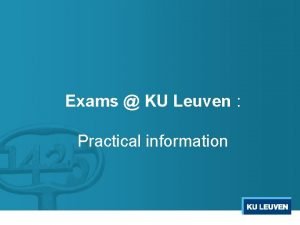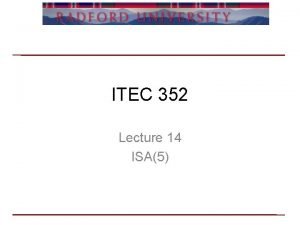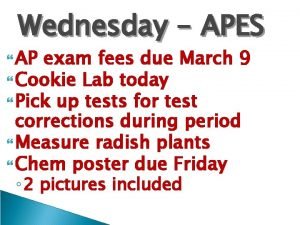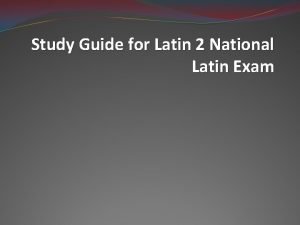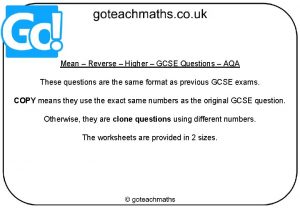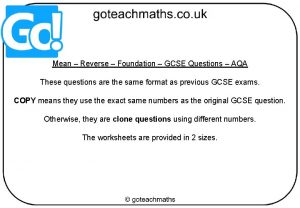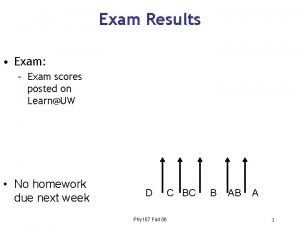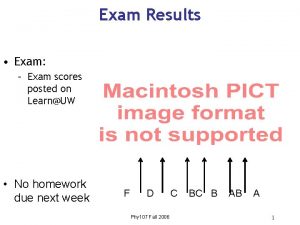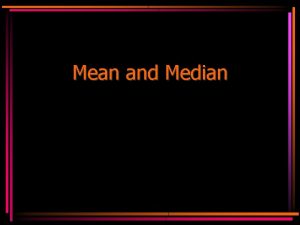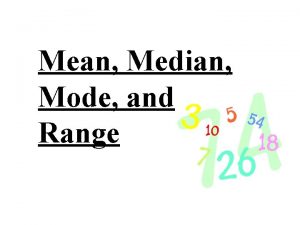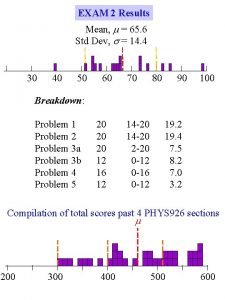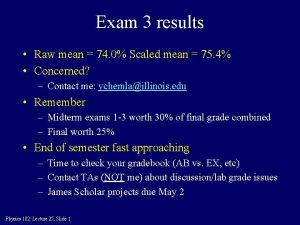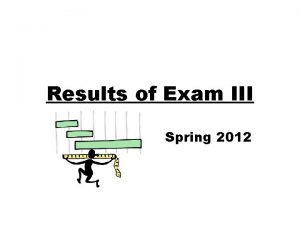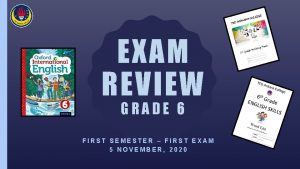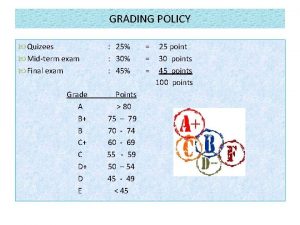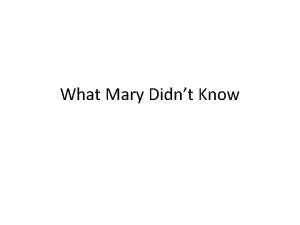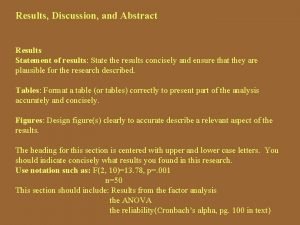Results for Exam 2C 140305 Mean grade 80














































- Slides: 46

Results for Exam 2_C 1403_05: Mean grade = 80, Median grade = 82 For any questions on the exam, please post on the discussion board.

Results of Course evalution after exam 2 Test: Class Survey after Exam 2 N/A: No Answer Helpfulness Please rank the following in terms of their assistance to you in preparing for the exam. Question 1: Class Lectures a: very useful 69% b: useful Question 2: Question 3: 17% Course. Works N/A Question 1: Courseworks worked well for me to obtain information on the course syllabus and exam materials. a: strongy agree 54% b: agree 41% c: disagree 5% Question 2: The quicktime movies were useful in clarifying and reinforcing concepts related to the course content in the book and lectures. c: not useful 13% a: Strongly agree 22% Homework assignments from the text b: agree 58% a: very useful 20% c: disagree 18% b: useful 63% c: not useful 17% Question 3: The powerpoint presentations were useful in clarifying and reinforcing concepts related to the course content in the book and lectures. Multiple choice homework assignments a: strongly agree 30% a: very useful 47% b: agree 61% b: useful 39% c: disagree 7% c: not useful 13%

Exam N/A Question 1: On the average, how many hours per week have you spent preparing for the course by reading, studying for quizzes or completing homework assignments? Question 4: The exam covered materials that were stressed in the practice multiple choice questions. a: strongly agree 29% a: Less than 5 h 15% b: 5 -10 h 45% c: 11 -15 h 28% d: 16 -20 h 7% b: agree 60% c: disagree 8% d: strongly disagree 4% e: More than 20 h 6% Question 2: Please indicate your opinion of the exam. The exam covered materials that were stressed in the homework. a: strongly agree 17% b: agree 65% c: disagree 14% d: strongly disagree 4% Question 3: lectures. The exam covered materials that were stressed in the Question 5: The exam covered materials that were stressed in the recitation sections. a: strongly agree 8% b: agree 49% c: disagree 30% d: strongly disagree 11% Question 6: Based on the information presented concerning the exam, the exam was fair. a: strongly agree 26% a: strongly agree 25% b: agree 60% b: agree 63% c: disagree 11% c: disagree 8% d: strongly disagree 3%

Ratings N/A Question 1: Instructor: Organization and Preparation a: excellent 39% b: very good 44% Question 4: Question 2: Instructor: Approachability 36% b: very good 42% Question 5: c: satisfactory 19% d: poor 19% b: very good 49% d: poor 2% a: excellent c: satisfactory 27% c: satisfactory 16% d: poor Course: Appropriateness of Workload N/A 0% Course: Overall Quality a: excellent 18% b: very good 52% c: satisfactory 25% 2% d: poor Question 3: 5% 4% Course: Amount Learned a: excellent 20% b: very good 49% c: satisfactory 25% d: poor 4% Question 6: Quality of Textbook a: excellent 8% b: very good 33% c: satisfactory 36% d: poor 15%

Chapter 18 Molecular orbitals and spectroscopy 18. 1 Diatomic molecules 18. 2 Polyatomic molecules 18. 3 Conjugation of bonds and resonance structures 18. 4 The interaction of light and matter (spectroscopy) 18. 5 Photochemistry Atmospheric photochemistry Special Topic: Buckyballs (C 60) and molecules@C 60

18. 3 Conjugation of bonds. Resonance structures Conjugation: delocalization from overlap of orbitals Connection between MO theory and Lewis resonance structures MOs of conjugated molecules Conjugation of orbitals and resonance Resonance: 1, 3 -butadiene and benzene Conjugation and light absorption

Two atoms: Ethylene (1) Lowest MO has no nodes; (2) each higher MO has one more node; (3) each MO has the symmetry of the molecule One node No nodes

Three atoms: Molecular pi orbitals No nodes ( ) Two nodes ( ) One node (Non bonding, nb) Energy ranking: ���� nb��� (order of nodes)

Four atoms: The molecular orbitals for a 1, 3 -diene Three nodes Two nodes One node No nodes

Benzene: A closed ring has some special properties Three nodes: one orbital Two nodes; Two equal energy orbitals One node; Two equal energy orbitals No node; one orbital

Two descriptions of benzene Valence bond: bonds localized Molecular orbital: bonds delocalized

18. 4 The interaction of light and molecules. Molecular spectroscopy Classifications of electromagnetic radiation: Spectral classification: X-ray, Ultraviolet, Visible, Infrared, Microwave, Radio Spectroscopic classification Electronic spectroscopy, Vibrational spectroscopy, Spin spectroscopy (Magnetic resonance) Absorption of light and color Photochemistry: photosynthesis, vision, atmospheric, toxic, theraputic

Photochemistry: involves electronically excited states

The distance and size scales of the electromagnetic spectrum

Energy Scales: Why the visible region works for vision

Photochemistry and spectroscopy both involve the absorption of photons to change a structure The configurations of electron, the vibrations of atoms, the orientation of spins

As conjugation is extended, the wavelength of absorption increases Energy gap decreases: Wavelength increases beta Carotene

Photochemistry: the science of chemical reactions which occur from electronically excited states of molecules R + h *R Chemical reactions *R is an electronically excited state Some important photochemical enents: Photosynthesis (electron transfer) Vision (cis-trans isomerization) Atmospheric: ozone layer (dissociation)

A widely read text on the subject of photochemistry

Vision: Early theories of light were theories of vision. Photosynthesis: Life requires the capture, storage and release of the sun’s energy. Wald Nobel in Medicine Mechanism of Vision Calvin Marcus Nobels in Chemistry Mechanism of Photosynthesis

Solar Radiation • What wavelengths are present? This depends on the wavelengths given off by the sun AND the wavelengths absorbed by the atmosphere

Photochemistry and spectroscopy of the atmosphere Penetration of electromagnetic radiation through the atmosphere

Water + Carbon dioxide = Food (carbohydrates) + Oxygen Sun: like a bell ringing out light

Chlorophyll

Photosynthesis: Ch + h *Ch + Q *Ch (electrically excited) Ch+ + Q- (electron transfer) Photosynthesis: 6 H 2 O + 6 CO 2 = C 6 H 12 O 6 + 6 O 2 Sun

Vision: triggered by a photochemical reaction

The effect of photoexcitation of a electron to a * orbital: the double bond is broken 2 electronic configuration: double bond keeps the molecule planar and prevents twisting about the C=C bond ( )1( *)1 electronic configuration: double bond broken and twisting occurs about the C-C bond

Rotation about a C=C* bond causes cis-trans isomerization The cis to trans isomerization triggers vision

Vision results from the change of a shape of ca. 2 nm = 0. 2 x 10 -9 m trans-retinal cis-retinal

Atmospheric photochemistry: production and destruction of ozone Photodissociation of O 2: O 2 + h O+O Reaction of O with O 2: O 3 O + O 2 Ozone protection: O 3 absorbs light whose wavelength is in the 200 -350 nm region of the spectrum Fluorocarbons absorb light and produce Cl atoms react with O 3 to destroy the ozone: Cl + O 3 Cl. O + O 2

Photochemistry and biology Photons can be toxic (cause DNA bases to dimerize) Photons can be therapeutic: phototherapy Photons can track thoughts, one molecule at a time Photons can image whole bodies and search for disease

Phototoxicity: Damage to DNA • DNA • 2’ Deoxyribo Nucleic Acid

DNA: UV photochemistry Photons cause two DNA bases to link: this kills the cells containing the irradiated DNA

Singlet molecular oxygen: and excited state of ordinary oxygen The Aufbau of the MOs of O 2 Hund’s rule states: When there are two electrons to be placed in two orbitals of equal energy, the lowest energy configuration places one electron in each orbital with parallel spins, a triplet state

Electronic states of molecular oxygen: two low lying singlet states

Direct spectroscopic detection of 1 O 2 3 O 2 + h : phosphorescence at 1270 nm

Photodynamic Therapy usinglet oxygen Only the affected organ irradiated with light Porphyrin injected into patient 1 O 2 kills cancer cells in irradiated area (Abs 390 - 450 nm) Patient cured!

Irradiating babies with jaundice causes a photochemical change that causes the jaundice pigment to become water soluble and to be excreted

The BIG One! Flow diagram for revolutionary science: Extraordinary claims that become accepted and are integrated into “normal science. ”

Different forms of elemental carbon: from diamond to graphite to buckyballs! Diamond C 60 Graphite He@C 60

An Extraordinary Claim: Carbon can exist in an elemental form that has a structure reminiscent to a soccer ball. The first “evidence” for the special stability of C 60 Discovery of C 60 “Buckyballs” Pathological Science or Revolutionary Science? Would you have predicted a Nobel Prize?

Robert Curl Harold Kroto Richard Smalley The Nobel Prize in Chemistry 1996 “for the discovery of fullerene” The proposal of Buckeyballs turned out to be revolutionary science

Buckyballs pulled into nanowires: Carbon nanotubes!

Nanodevices: A carbon nanocar rolling on a gold surface Thanks to Whitney Zoller

Putting H 2 inside a buckyball! Open the buckyball, pressure in gaseous H 2, close buckyball! Professor Koichi Komatsu (Kyoto University)

 Prayer before a big test
Prayer before a big test Ku leuven exam results
Ku leuven exam results Csca program
Csca program Itec exam results
Itec exam results Fe exam results wednesday
Fe exam results wednesday Latin 2 final exam answers
Latin 2 final exam answers Ncae form an inventory of occupational interest
Ncae form an inventory of occupational interest Gcse meaning
Gcse meaning What does gcse stand for
What does gcse stand for Formuö
Formuö Typiska drag för en novell
Typiska drag för en novell Nationell inriktning för artificiell intelligens
Nationell inriktning för artificiell intelligens Vad står k.r.å.k.a.n för
Vad står k.r.å.k.a.n för Varför kallas perioden 1918-1939 för mellankrigstiden
Varför kallas perioden 1918-1939 för mellankrigstiden En lathund för arbete med kontinuitetshantering
En lathund för arbete med kontinuitetshantering Kassaregister ideell förening
Kassaregister ideell förening Personlig tidbok fylla i
Personlig tidbok fylla i Sura för anatom
Sura för anatom Vad är densitet
Vad är densitet Datorkunskap för nybörjare
Datorkunskap för nybörjare Tack för att ni lyssnade bild
Tack för att ni lyssnade bild Mall debattartikel
Mall debattartikel Autokratiskt ledarskap
Autokratiskt ledarskap Nyckelkompetenser för livslångt lärande
Nyckelkompetenser för livslångt lärande Påbyggnader för flakfordon
Påbyggnader för flakfordon Arkimedes princip formel
Arkimedes princip formel Offentlig förvaltning
Offentlig förvaltning Bo bergman jag fryser om dina händer
Bo bergman jag fryser om dina händer Presentera för publik crossboss
Presentera för publik crossboss Jiddisch
Jiddisch Plats för toran ark
Plats för toran ark Treserva lathund
Treserva lathund Mjälthilus
Mjälthilus Claes martinsson
Claes martinsson Centrum för kunskap och säkerhet
Centrum för kunskap och säkerhet Programskede byggprocessen
Programskede byggprocessen Mat för unga idrottare
Mat för unga idrottare Verktyg för automatisering av utbetalningar
Verktyg för automatisering av utbetalningar Rutin för avvikelsehantering
Rutin för avvikelsehantering Smärtskolan kunskap för livet
Smärtskolan kunskap för livet Ministerstyre för och nackdelar
Ministerstyre för och nackdelar Tack för att ni har lyssnat
Tack för att ni har lyssnat Vad är referatmarkeringar
Vad är referatmarkeringar Redogör för vad psykologi är
Redogör för vad psykologi är Matematisk modellering eksempel
Matematisk modellering eksempel Atmosfr
Atmosfr Borra hål för knoppar
Borra hål för knoppar

